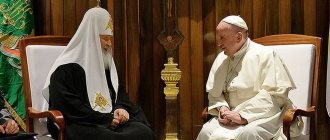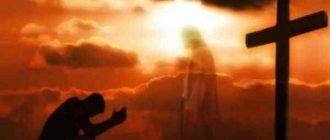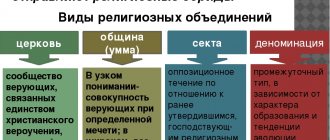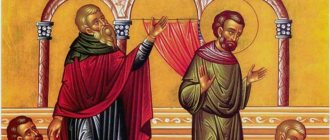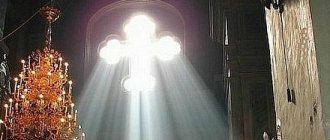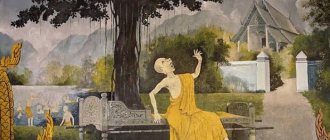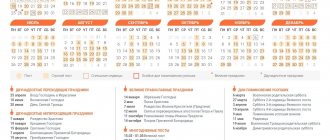As is known, in the Orthodox world only six monasteries have Lavra status. Three of them are in Ukraine. These are the Holy Dormition Kiev-Pechersk Lavra in Kyiv, which received it back in 1598, the Holy Dormition Lavra in Pochaev and the Svyatogorsk Holy Dormition Lavra in the Donetsk region.
At the same time, despite the fact that Ukraine is one of the most important centers of the Orthodox world, its church is now in a state of schism, having received autocephaly from the Patriarchate of Constantinople, which is not recognized by the majority of local churches. All this makes it difficult to understand which faith Ukrainians have is correct.
Most Ukrainians are Christians
It is quite easy to understand which religion is most popular among Ukrainians in our time. The fact is that the predominant number of believers in Ukraine are Christians.
Of the 47 million population, 33 million, or 70%, call themselves believers. At the same time, about 5 million people regularly visit temples.
33 million
or 70% of the population of Ukraine are Christian believers
Ukraine is the canonical territory of the Ukrainian Orthodox Church of the Moscow Patriarchate, which is the most widespread denomination throughout its territory, with the exception of the three Galician regions.
The number of Orthodox believers of the UOC is about 5 million people. or 10.9% of the population, parishes - 11,358 (as of 2009). At the same time, a large Ukrainian diaspora lives in Russia, mostly Orthodox, therefore, when asked what religion Ukrainians profess in Russia, it is necessary to answer that it is Orthodoxy.
Baptism of Vladimir the Great. Fresco by Viktor Vasnetsov. Christianity in Ukraine appeared after the baptism of Rus' by the Holy Equal-to-the-Apostles Prince Vladimir in 980. Photo: upload.wikimedia.org
In addition, there are also schismatic organizations in Ukraine, of which the main ones are:
- "Ukrainian Orthodox Church - Kiev Patriarchate" (UOC-KP).
- "Ukrainian Autocephalous Orthodox Church" (UAOC).
- “Ukrainian Autocephalous Orthodox Church (canonical)” - UAOC(k).
- “Ukrainian Autocephalous Orthodox Church (renewed)” - UAOC(o).
- Ukrainian Apostolic Orthodox Church.
In Western Ukraine, in Galicia (Lviv, Ternopil, Ivano-Frankivsk regions), the Uniate Ukrainian Greek Catholic Church dominates. Fixed religious communities of Muslims and Jews.
In addition, in Ukraine there are followers of Buddhism, Hinduism and new religions. There is a growing influence of Protestant churches actively involved in missionary activities.
Constitution of Ukraine. The Constitution of Ukraine guarantees freedom of religion. Photo: upload.wikimedia.org
Religion in Ukraine is separated from the state. Art. 35 of the country's Constitution establishes freedom of religion, the unhindered exercise of religious cults and rituals, individually or collectively, and the conduct of religious activities.
The church and religious organizations in Ukraine are separated from the state, and the school is separated from the church. No religion can be recognized as state or compulsory.
Gallery
- Assumption Cathedral, Kyiv (1078, rebuilt in 2000)
- St. Michael's Golden-Domed Cathedral, Kyiv (1113, rebuilt in 1999)
- Church of the Holy Mother of God Pirogoshcha, Kyiv (1132, rebuilt in 1997–1998)
- Church of St. Nicholas, Kyiv (1899–1909)
- Trinity Cathedral, Chernigov (1695)
- Trinity Cathedral, Sumy (1913)
- Latin Cathedral, Lviv (c. 1493)
- St. George's Cathedral, Lviv (1760)
- Church of St. Elizabeth, Lviv (1903–1911)
- Church of the Nativity, Ternopil (1602–1608)
- Holy Resurrection Cathedral, Ivano-Frankivsk (1729–1763)
- Transfiguration Cathedral, Vinnitsa (1758)
- Church of St. Martin, Mukachevo (1904)
- Church of the Nativity of the Blessed Virgin Mary, Stryi (1425, rebuilt in 1891).
- Church of St. Bartholomew, Drohobych (15th century, rebuilt 1906–1913)
- Church of St. Stanislaus, Chortkiv (1619, rebuilt at the beginning of the 20th century)
- St. Anne's Church, Bar (1811)
- Church of the Assumption of the Heart of Jesus, Chernivtsi (1892–1894)
- Neo-Gothic Church of St. Anne, Ozeryany (1875)
- Central Lutheran Cathedral Ukraine St. Paul, Odessa (1827)
- Church of St. Nicholas, Dnieper (1895)
- Church of the Assumption of the Blessed Virgin Mary, Otynia (1905–1918)
- Evangelical Presbyterian Church, Odessa (1896)
70% of Ukrainians consider themselves Orthodox, while the Orthodox world in Ukraine is split
Statistics speak eloquently about what religion Ukrainians belong to. This is how the majority of the population of modern Ukraine (about 70%) and the overwhelming majority in the central, eastern and southern regions of the country consider themselves Orthodox. At the same time, the number of Orthodox Christians who visit the temple at least once a month is about 18%.
Monastery of the Kiev Pechersk Lavra, Kyiv, Ukraine. Most Ukrainians consider themselves Orthodox. Photo: upload.wikimedia.org
Orthodox Christianity began to penetrate into Rus', which included the territory of present-day Ukraine, back in the time of Askold and Olga, who was baptized probably in 957. As a result of the Baptism of Rus' in 988, the Kiev Metropolis of the Patriarchate of Constantinople was established.
The Syrian Michael became the first metropolitan of Kyiv, and the main cathedral of the new metropolis was the Tithe Church of Kyiv. Orthodoxy in Ukraine has a complex and tragic history.
Orthodoxy experienced difficult times after 1991, when the USSR collapsed.
At the same time, since 1990, processes have been underway that allowed the Council of Bishops of the Russian Orthodox Church to adopt the “Regulations on the Exarchates.” The document granted the Ukrainian (as well as the Belarusian) exarchates greater rights in self-government, as well as the right to be called the Ukrainian Orthodox Church (UOC).
Until 2021, on the territory of independent Ukraine, which became independent in June 1992, within the administrative borders of the Ukrainian Soviet Socialist Republic (UKSR), three large jurisdictions coexisted, calling themselves Orthodox churches: the Ukrainian Orthodox Church (Moscow Patriarchate or UOC MP), the Ukrainian Orthodox Church of the Kyiv Patriarchate (UOC-KP), Ukrainian Autocephalous Orthodox Church (UAOC).
The Ukrainian Orthodox Church within the Russian Orthodox Church (Moscow Patriarchate) and the Bessarabian Metropolis of the Romanian Orthodox Church have recognized canonical status.
There is also a Ukrainian Greek Catholic Church, which dates back to the Russian Uniate Church, formed in the Polish-Lithuanian Commonwealth as a result of the Union of Brest (1596), and whose parishes were Orthodox in certain historical periods.
Tree of schisms in the Christian Church. Orthodoxy in Ukraine is in a state of schism. Photo: patriarch.ua
Currently, Ukrainian Orthodoxy is in a state of schism. The fact is that in April 2021, the Synod of the Patriarchate of Constantinople decided to grant autocephaly to Orthodox Christians in Ukraine.
As a result, on December 15, 2021, on the basis of the UOC-KP and UAOC, a new structure was established in Kyiv - the Orthodox Church of Ukraine (OCU).
December 15, 2018
on this day a new structure was approved in Kyiv - the Orthodox Church of Ukraine
In January 2021, the Patriarchate of Constantinople awarded it the status of autocephalous, including it in its diptych of autocephalous Orthodox churches. The actions of the Patriarchate of Constantinople were not recognized by the Moscow Patriarchate, which considers the territory of the former Ukrainian SSR to be part of its “canonical territory.”
Story
In the 12th century, most of the territory of present-day Ukraine was part of Kievan Rus.
The term “Ukraine” was originally used in the sense of “outskirts” - referring to the territories bordering the steppe, from where the Tatars launched raids on the Slavic population. After the collapse of Kievan Rus, the territory of the future Ukraine began to be seized by its neighbors, primarily Lithuania and Poland. In 1654, after an uprising led by Bohdan Khmelnytsky, Left Bank Ukraine was reunited with Russia. By the end of the 18th century (mainly due to the partitions of Poland), most of the Right Bank Ukraine also went to Russia.
Since the annexation of Left Bank Ukraine to Russia, the development of mineral resources and industrial development begin here. At the beginning of the century, industrial growth rates were even higher than in North America and Western Europe. The reasons are a short period of serfdom, lack of competition, high profit margins, attracting foreign capital.
In con. 1917 - beginning 1918 Soviet power is established in Ukraine.
As a result of the Soviet-Polish war of 1920, Western Ukraine was annexed by Poland and was again annexed in 1939. In 1940, Northern Bukovina and part of Bessarabia became part of Ukraine.
In 1941-1945. The territory of Ukraine was subjected to German occupation. It was liberated by the Soviet army by the beginning of 1945. During the years of Soviet power, the country implemented an intensive industrialization program. In 1954, Russia transferred the Crimean region to Ukraine. In April 1986, a major accident occurred at the Chernobyl nuclear power plant near Kiev, the consequences of which affected many areas of Ukraine, Belarus and Russia.
After the collapse of the Soviet Union in August 1991, the country's independence was declared.
In February 2014, an armed coup took place in Kyiv; President Yanukovych fled to Russia. The Crimean Autonomous Republic declared the new government illegitimate and refused to obey it. On March 16, a referendum was held in Crimea, according to the results of which 96.77% of Crimeans (with a turnout of 83.1%) expressed a desire for the Crimean Republic to join Russia. On March 17, the Crimean Parliament declared the state independence of Crimea. On March 18, an agreement on the entry of the Crimean Autonomy and Sevastopol into Russia was signed in Moscow; on March 20, the agreement was ratified by the State Duma of the Russian Federation. Ukraine, EU countries and the United States sharply condemned Russia's actions, recognizing them as contrary to international law.
Catholicism in Ukraine developed after the Union of Lublin
In 1569, as a result of the Union of Lublin, Volhynia, Podlasie, Podolia, the Bratslav region and the Kiev region came under Polish rule. In 1596, the Brest Union of the Orthodox Church of the Kyiv Metropolitanate with the Catholic Church was concluded, which caused the conversion of part of the Russian nobility and the common population to Catholicism.
From that moment on, the spread of Catholicism began in the territory of modern Ukraine.
Jan Matejko, "Union of Lublin". The painting was painted in 1869, that is, on the 300th anniversary of the conclusion of the Union. Catholicism in Ukraine began to spread after the conclusion of the Union of Lublin. Photo: upload.wikimedia.org
Now the number of Catholics in Ukraine is estimated at 4 - 5 million people. Catholicism of both the Western and Eastern rites is more widespread in the west of the country, although the network of Catholic parishes covers the entire territory of Ukraine.
As for the Roman Catholic Church, diplomatic relations between Ukraine and the Holy See were established on February 8, 1992.
February 8, 1992
on this day diplomatic relations were approved between Ukraine and the Roman Catholic Church
On this day, Pope John Paul II issued the breve "Ukrainam Nationem", in which he founded the Apostolic Nunciature in Ukraine. Antonio Franco became the first nuncio in Ukraine. Since 2015, Claudio Gugerotti has served as Ambassador of the Holy See.
Catholics of the Latin rite on the territory of Ukraine are united in 6 dioceses subordinate to the archdiocese of Lviv. The number of believers is 500 - 800 thousand people. The Catholic bishops of the Latin Rite of Ukraine constitute the Conference of Catholic Bishops, formed in 1994.
Catholicism began to spread in Ukraine after the conclusion of the Union of Lublin.
Ukrainian Greek Catholics make up the majority of the population in Galicia (Lviv, Ternopil, Ivano-Frankivsk regions) and Transcarpathia. The Ukrainian Greek Catholic Church has the status of the Supreme Archbishopric. Structurally, it is united into 4 metropolises, to which 2 archdioceses, 7 dioceses and 3 exarchates are subordinated on the territory of Ukraine.
The UGCC has an extensive church structure outside of Ukraine. The Greek Catholic Diocese of Mukachevo is independent of the Ukrainian Greek Catholic Church and is one of the three constituent parts of the Ruthenian Greek Catholic Church. The Mukachevo diocese has 380 thousand members, 383 parishes, 238 priests.
Do believers go to church?
If indicators of religious self-identification, according to sociologists' research, are falling, then religious behavior, on the contrary, is becoming more popular. 52% of respondents attend church services, 23% of them go to church once a week or more often. Sociologists double-checked these data by asking each respondent whether he had been to church last Sunday. 21% of respondents answered affirmatively.
Every tenth Ukrainian regularly financially supports the church. Moreover, the level of support depends on the region. In the east of the country it is lower (5.6% of respondents donate to churches), and in the west it is higher (21.9%).
Protestants are the third largest group of Christians in Ukraine
Protestantism in Ukraine is the third largest group of Christian believers after the Orthodox and Greek Catholics. Protestants also outnumber Roman Catholics. According to various studies, Protestants make up from 1.3% to 2.4% of the population. The count is complicated by the fact that not all Protestant churches and groups are officially registered and keep detailed records.
Map of Ukraine “number of Protestant communities” for 2010 in Ukrainian. Protestantism is the third largest Christian denomination in Ukraine
Protestantism on the territory of Ukraine does not represent a single whole, but is divided into several confessions and many denominations.
At the same time, several organizations coordinating Protestant churches: the Council of Evangelical Protestant Churches of Ukraine, the Ukrainian Evangelical Alliance, and Protestants also take an active part in the All-Ukrainian Council of Churches and Religious Organizations and the Ukrainian Bible Society.
Protestantism is the third largest Christian denomination in Ukraine.
Among Protestant religious communities, the most influential and authoritative Protestant church remains the All-Ukrainian Union of Churches of Evangelical Christian Baptists.
The second Protestant association in terms of the number of religious organizations is the All-Ukrainian Union of Churches of Christians of the Evangelical Faith-Pentecostals. The third is the Ukrainian Union Conference of the Seventh-day Adventist Church. In addition, Lutherans, Adventists, Charismatics, etc. are also represented in the country.
Judaism
Kharkov Synagogue
Main article: History of Jews in Ukraine
The size of the Jewish population of Ukraine has changed over time. Jews are, first of all, an ethnic group closely associated with the religion of Judaism. Jews in Ukraine are estimated from 100 to 300 thousand. However, ethnic Jews may be non-religious or practice religions other than Judaism. It is estimated that only 35-40% of Ukraine's Jewish population is religious. Most observant Jews practice Orthodox Judaism, but there are also communities of Chabad-Lubavitch and Reform Judaism, Conservative Judaism, and Reconstructionist Judaism.
Jewish communities use Russian, Hebrew, Yiddish and Ukrainian. As of 2021, 0.4% of the population of Ukraine were Jews professing Judaism. That same year, 271 Jewish religious communities were officially registered.
Ukraine is the birthplace of Lubavitcher Hasidism
Followers of Judaism lived on the territory of modern Ukraine for two millennia. The majority of the Jews of Ukraine historically belonged to Ashkenazim, descendants of immigrants from medieval Germany and Eastern European countries.
At the same time, Ukraine is a holy place for followers of the so-called Bratslav Hasidism. This is one of the movements of Hasidic Judaism, founded by Rabbi Nachman of Bratslav, great-grandson of the Baal Shem Tov. The grave of Tsaddik Nachman is located in Uman, where his followers make a pilgrimage every year.
Bratslav Hasid with his sons on the streets of Uman. Ukraine annually welcomes thousands of Hasidic pilgrims, eager to visit many of their spiritual leader, Tzaddik Nachman, in Uman. Photo: chronicika.info
In our time, as of 2015, 300 Jews were registered in the country. The main ones are:
- Association of Jewish Religious Organizations of Ukraine (OIROU).
- All-Ukrainian Congress of Jewish Religious Organizations.
- Association of Hasidim Chabad Lubavitch Jewish religious organizations of Ukraine.
Ukraine is the birthplace of Bratslav Hasidism.
In addition, according to press reports, Kiev is home to the largest Jewish Messianic community (Kiev Jewish Messianic Community) in the world (more than 1000 members).
The Messianic Jewish movement is actively involved in charity work, providing assistance to the poor (lunches, humanitarian aid: clothing, shoes, basic necessities, etc.). Orthodox Jews are hostile to the activities of this organization.
Islam in Ukraine is widespread among the Crimean Tatars
The first evidence of Islam in the lands of present-day Ukraine is associated with the Khazar Khaganate that emerged in the 7th century. Later, the Crimean Tatars became the main followers of Islam. During Soviet times, these people, as well as Islam, like other religions in the country, were persecuted.
Why is religion needed?
The revival of Islam in Ukraine is associated with the early 1990s. It was then that Muslims were able to openly declare their religious affiliation, freely satisfy their religious needs, and perform the rituals of Islam, following the traditions of their ancestors.
Mosque of Khan Uzbek. Solkhat (Old Crimea). Islam in Ukraine is professed mainly by Crimean Tatars. Photo: upload.wikimedia.org
Nowadays, as of 2015, 220 Islamic organizations are registered in Ukraine. Among them:
- Spiritual Administration of Muslims of Ukraine (DUMU);
- Spiritual Administration of Muslims of Ukraine “Ummah” (DUMU “Ummah”, Kyiv);
- Spiritual Administration of Muslims of Crimea (SUMK);
- religious administration of independent Muslim communities “Kiev Muftiyat” (Kyiv) and others.
Paganism and native faith
Prayers in the temple of the church of the indigenous Ukrainian national faith. The rite of worship was led by the priests of the Fire of the Ancestors of the Slavic Native Faith.
Rodnovery
Slavic native faith (Rodnovery, Ukrainian: Рідновірstvo Ridnovirstvo
, Ridnovirya
Ridnovirya
or Ridna Vira
Ridna Vira
, otherwise called Orthodoxy
Pravoslavya
- “Orthodoxy”) is represented in Ukraine by numerous organizations. As of 2021, there are 138 registered communities, divided between the Church of Indigenous Ukrainian National Faiths (Ridna Ukrainian National Faith, RUNVira) - 72 churches, Fire of the Ancestors of Primordial Orthodoxy (Ancestral Arch of the Russian Orthodox Faith) - 21 churches, Church of Ukrainians Ukrainian pagans (Ukrainian Churches Pagans) - 7 churches, Federation of Ukrainian Rodnovers (Ob'dnannya Rіdnovіrіv of Ukraine) - 6 churches and other organizations - 32 churches. The Federation of Rodnovers of Ukraine was founded in 1998 by Galina Lozko and has branches in Kyiv, Kharkov, Odessa, Boryspil, Chernigov, Nikolaev, Lviv and Yuzhnoukrainsk. There are many other unregistered groups and federations, for example, the Fire of the Ancestors of the Slavic Native Faith (Rodove Vognishche Slovyanskoi Ridnoi Viri), the Wrath of God of the Native Orthodox Faith, the North Caucasus Scythian Regional Fire, the Order of the Knights of the Sun God and the Rodolubie Russian Rodnover Community.
Lev Silenko founded the Church of the Native Ukrainian National Faith (RUNVira) in 1966 in Chicago, USA, and only after the collapse of the Soviet Union in 1991 opened his first temple in the Ukrainian homeland. in Spring Glen, New York, USA. The doctrine of the Church of the indigenous Ukrainian national faith, "Silenkoism" or "Dazhdbogism", is monistic and centered around the god Dazhdbog.
As of 2021, there were 0.1% pagan believers in Ukraine, with a higher percentage in Central Ukraine. Sociologists estimated between 1,000 and 95,000 Rodnovers (0.2%) in Ukraine in the early 2000s. Since 1999, the Book of Veles, which is a central philosophical text for many Rodnoverian churches, has been included in school curricula in Ukraine.
Rodnovery played a significant role in the War in Donbass. The Azov battalion, fighting for Kyiv, is mainly composed of Ukrainian Rodnovers. He is reported to be collaborating with the Kyiv Patriarchate and seizing its churches. On the other side of the spectrum, the Russian Rodnovers who fight for Moscow are organized into battalions such as the Svarog Battalion (Vostok Brigade), the Svarozhich Battalion (the Slavic Unification and Revival Battalion) and the Rusich Rota. Donbass has been documented as a stronghold of Rodnoveria; there are Russian Rodnover organizations that reorganize local villages and society according to traditional Indo-European trifunctionality (in which men are born to play one of three roles in society, be it priests, warriors or farmers).
Native places of power
The most famous temple is located on Khortytsia in Zaporozhye. According to ancestral beliefs, the entire island is a sacred place with strong energy. Idols and temples are still preserved. Modern followers of the old faith often visit this place.
There is also a temple in Kyiv that has been preserved from the times of Kievan Rus.
There are other religious associations operating on the territory of Ukraine
In addition to Christian, Jewish and Muslim religious organizations, representatives of other religions operate on the territory of Ukraine. For example, followers of Judaism, including Vishnaism (the Society of Krishna Consciousness), live here.
2015
this year 50 Hindu organizations and 60 Buddhist communities were registered in Ukraine
As of 2015, there were 50 registered Hindu women's organizations. There are also 60 Buddhist communities in the country. Among them: Ukrainian Association of Karma Kagyu Buddhists, Spiritual Administration of Buddhists of Ukraine.
Buddhists of the Nipponzan Myohoji Order, Kyiv, Ukraine. There are Buddhists of different schools and orders in Ukraine. Photo: upload.wikimedia.org
In addition to traditional religions, representatives of non-traditional religious associations also operate on the territory of Ukraine. For example, followers of Rastafarianism work here. In addition, 140 neo-pagan organizations are also registered.
By leaving a comment, you accept the user agreement
Used materials
- “The number of Orthodox parishes in Ukraine is declining,” 12.2.2009:
- Priest Rostislav Yarema. Church schisms in Ukraine. Kyiv, 2007. P.87
[1] Data for 2007 are provided according to the press service of the UOC with reference to the State Committee of Ukraine for Nationalities and Religions. Kyiv, 2007.
[2] “Information report of the Ministry of Culture of Ukraine “On the state and trends in the development of the religious situation and state-confessional relations in Ukraine for 2012” (Summary - in Ukrainian):
[3] the document does not provide data separately for each “part” of the UAOC
[4] According to the State Committee for Nationalities and Religions of Ukraine, statement by the head of the committee, Alexander Sagan, press conference in Kyiv 11.2.2009. See “The number of Orthodox parishes in Ukraine is declining,” 12.2.2009,
